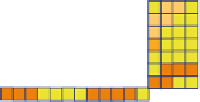Geoscience Reference
In-Depth Information
Note to graphics - Ensure grid edges align - redraft if necessary?
a
Ripple laminaset
20mD
48
-
7
100mD
k
-
7
34
b
Trough crossbed set
1200mD
759
63
-
100mD
k
63
336
-
Fig. 3.12
Example tensor permeability matrices calculated for simple 2D models of common sedimentary structures
in a vertical flow and requires a k
zx
permeability
term in the Darcy equation (for a 2D tensor).
Example solutions of permeability tensors
for simple geological models are given by
Pickup et al. (
1994
) and illustrated in
Fig.
3.12
. Ripple laminasets and trough cross-
beds are two widespread bedding architectures
found in deltaic and fluvial depositional settings
-ripplelaminasetstendtobe2-4cminheight
while trough cross-bed sets are typically
10-50 cm in height. These simple models are
two dimensional and capture typical geometry
and permeability variation (measured on out-
crop samples) in a section parallel to the depo-
sitional current. In both cases, the tensor
permeability matrices have relatively large
off-diagonal terms, 15 and 8 % of the k
xx
value, respectively. The negative off-diagonal
terms reflect the chosen coordinate system
with respect to flow direction (flow left to right
with z increasing downwards). Vertical per-
meability is also significantly lower than the
horizontal permeability due to the effects of
the continuous low permeability bottomset.
Geological elements like these will tend to fill
the volume within a particular reservoir unit,
imparting their flow anisotropy and cross-flow
tendencies on the overall reservoir unit. Of
course, real rock systems will have natural
variability in both architecture and petrophysical
properties, and our aim is therefore to represent
the expected flow behaviour. The effects of
geological architecture on flow are frequently
neglected - for example, it may be assumed
that a Gaussian random field represents the
inter-well porosity and permeability architecture.
More advanced, geologically-based, flow
modelling will, however, allow us to assess the
potential effects of geological architecture on
flow, and attempt to capture these effects as a
set of upscaled block permeability values. Struc-
tural architecture in the form of fractures or small
faults may also generate pervasive tendencies for
strongly tensorial permeability within a rock
unit. By aligning grid cells to geological features
(faults, dominant fracture orientations, or major
bed-set boundaries) the cross-flow terms can be
kept to a minimum. However, typically one
aligns the grid to the largest-scale geological
architecture (e.g. major fault blocks) and so
other smaller-scale features inevitably generate
some cross-flow.
3.2.6 Permeability in Fractures
Understanding permeability in fractured
reservoirs requires some different flow physics
- Darcy's law does not apply. Flow within a
fracture (Fig.
3.13
) is described by Poiseuille's









































